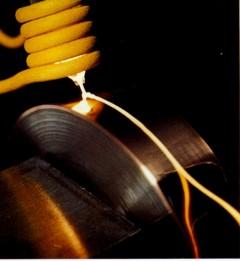Amorphous Alloys
 At an atomic level metals and alloys are normally polycrystalline, so although the amorphous form of these materials have mechanical, electrical and magnetic properties that are quite unique, such 'glassy' forms are really difficult to obtain. Until recently it was considered that amorphous alloys had to be formed by rapid quenching at cooling rates of order 106 degrees per second, and could therefore only be produced in the from of thin films or glassy metals. The scope for applications on a large scale was therefore extremely limited. However in the last few years techniques have evolved for forming true glassy ingots, and the group has now begun a study of these 'bulk amorphous alloys'.
At an atomic level metals and alloys are normally polycrystalline, so although the amorphous form of these materials have mechanical, electrical and magnetic properties that are quite unique, such 'glassy' forms are really difficult to obtain. Until recently it was considered that amorphous alloys had to be formed by rapid quenching at cooling rates of order 106 degrees per second, and could therefore only be produced in the from of thin films or glassy metals. The scope for applications on a large scale was therefore extremely limited. However in the last few years techniques have evolved for forming true glassy ingots, and the group has now begun a study of these 'bulk amorphous alloys'.
Very broadly these materials consist of at least three and possibly four or more atomic species of different diameters and with many competing crystalline aggregates. Quite generally many of these alloys are characterised by an exceptionally high strength to weight ratio with excellent elastic energy storage, and with highly novel applications already on the market ranging from golf clubs to bullet-proof vests! There is also considerable potential for applications in magnetism with materials ranging from ferromagnets with the lowest known coercivities to those that have not reached saturation in fields as high as 30 T, as well as superparamagnets with possible applications in recording heads (GMR) and magnetic refrigeration.
